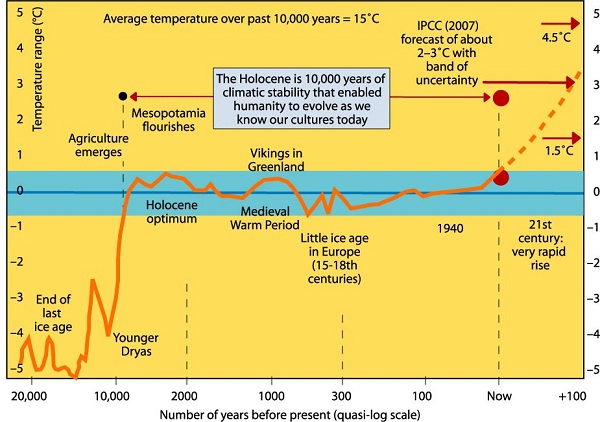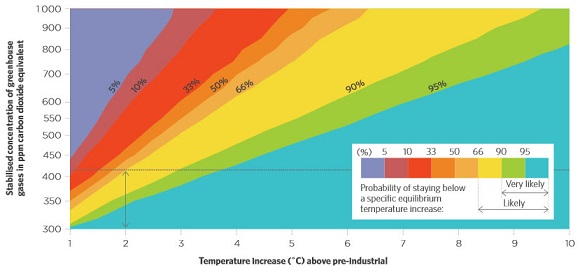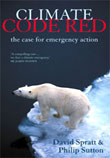Back in 2011 David Spratt took a look at where we were in relation to temperature rise and the Holocene. At 2000 we were at 0.7°C above the pre-industrial temperature. This happens to coincide with the Holocene maximum:

Spratt says James Hansen warns that at 0.7°C the ice sheets start to become unstable, so in terms of sea level rise alone we are entering a danger zone. Since then the temperature has risen ~ 0.15°C.
From this point of view the 2°C guardrail looks hazardous in the extreme.
In 2006 Hansen warned that a warming of 2 to 3 degrees above present is likely to give a sea level rise of 25 metres (Climate Code Red, p87).
Climate Code Red, by David Spratt and Philip Sutton in 2008, suggests that the 2°C guardrail is the answer to the wrong question. The question was, what is the minimum we need to do to avoid catastrophic climate change? The answer given was 2°C and CO2 concentrations of no more than 450 ppm. The real question should have been, what do we need to do to have a safe climate? Spratt and Sutton think 320 ppm and a temperature back in the Holocene range.
Two degrees they tell us will mean (p97):
- summer monsoons in northern China will fail
- agricultural production will fall in India’s north as forests die back and national production falls
- flooding in Bangladesh will worsen as monsoons strengthen and sea levels rise
- in the Andes, glacial loss will reach 40-60% by 2050, reducing summer run-off and causing horrendous water shortages in South American nations
- California will see a decline in the snowpack of one third to three quarters, with a loss of up to 70% in the Northern Rockies, which will devastate regional agriculture as melt run-off declines
- there will be a severe impact on world food supplies: in central and South America, maize losses are projected for all nations but two
- in 29 African countries, crop failure and hunger are likely to increase.
Without doubt the list is incomplete. I’ve spelt it out in detail, however, to illustrate the knowledge that was commonly available back then, a year before the 192 countries that participate in the UNFCCC decided in Copenhagen to adopt the 2°C guardrail as a desirable aim in December 2009.
On the same page Spratt and Sutton quote Hansen as nominating 425 ppm, plus or minus 75, as the tipping point for the total loss of ice sheets on the planet.
Spratt and Sutton also had something to say about risk. I’ll publish here again the Malte Meinshausen graph I found in The Climate Authority Review of targets:

The straight lines pinpoint about 425 ppm as associated with a 66% chance of staying within 2°C. Spratt and Sutton suggest we should use the standard of mortality risk commonly used in advanced economies in a variety of circumstances – one in a million. They say (p114):
- When approving new pharmaceuticals and designing aircraft, bridges, and large buildings, strict risk standards are applied: a widely used rule of thumb is to keep the risk of mortality to less than one in a million.
Spratt and Sutton blame the “political-corporate elite”, whoever they are, for getting us into this mess. A mind-set has certainly been established with considerable inertia. When this mind-set is broken we’ll know that policy makers are serious about saving the planet.
See also Spratt’s is climate change already dangerous? You’ll be unsurprised to find that he thinks it is.
Update: In the post IPCC Synthesis Report: you’ve been told! I asked the question Is a 2°C temperature rise safe?
David Spratt addressed this issue in September 2013. To summarise some of what he said:
- The tipping point for Greenland Ice Sheet has been revised down to +1.6ºC (uncertainty range of +0.8 to +3.2ºC) above pre-industrial. We are likely to hit +1.6ºC within a decade or two.
- It has been shown that “preserving more than 10 per cent of coral reefs worldwide would require limiting warming to below +1.5°C (atmosphere–ocean general circulation models (AOGCMs) range: 1.3–1.8°C) relative to pre-industrial levels”.
- Large-scale thawing of permafrost may have already started, but a 1.5ºC global rise in temperature compared to pre-industrial should be enough to start a general permafrost melt.
- Current levels of CO2 at about 400 ppm place us in the Middle Pliocene epoch (3.0–3.5 Myr ago) when sea levels were 25m plus or minus 5 higher than now.
- During the Eemian 123,000 years ago sea-level rises of 3 metres occurred within 50 years due to the rapid melting of ice sheets, when the energy imbalance in the climate system was less than at present.
See also:
Climate sensitivity and the myth of ‘burnable carbon’.
Related posts:
Climate change: reconnecting politics with reality
A choice of catastrophes: the IPCC budget approach
Adding to the muddle? The IPCC climate change mitigation report
IEA and the energy crunch of 2017
Assumptions underlying the CEF package
Reconciling estimates of climate sensitivity
Hansen worries that all hell will break loose
CO2 is scrambling our brains, but will it kill us all?
Science shows the need for urgent climate action
Climate change: the end of civilisation as we know it
IPCC on 1.5°C: the target is wrong, but we have a strong wake-up call
Trouble at the top of the world
Cool patch below Greenland is bad news
Cloud tipping point could yield a cataclysmic 14°C warming
For later posts on this theme see also tag Dangerous climate change.


The most optimistic view is that the US, China, EU, India consensus is real and will lead to accelerating climate action. Could be even faster if an economic consensus develops that a war on climate change is the only way to revive the world economy.
A less optimistic view is that a hunger driven breakdown of world peace will lead to the dramatic crashes in world population and industrial capacity before too much damage is done.
Then….